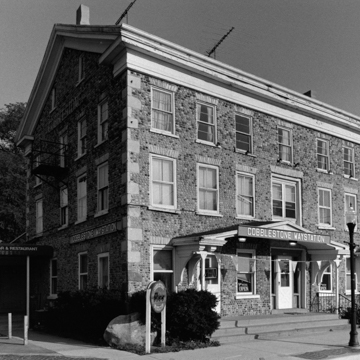In a state with an unusually large collection of cobblestone buildings, the Buena Vista House is the biggest and one of the finest (see RA2). Bradley was a young mason who ran a hotel in Milwaukee with his wife before moving to East Troy. In 1846, he built the stone walls of his new inn and began the laborious task of veneering them with cobblestones. Because it took so long to select the small stones and lay them in uniform courses, most masons working with this material veneered only the principal facade, leaving the rubble or quarried stone exposed at the sides and rear. But Bradley veneered all four sides, using colorful egg-shaped stones he had gathered from nearby lakes and running tooled V-shaped mortar joints between each horizontal course. The process took three years.
Like most cobblestone buildings, this one is a vernacular interpretation of Greek Revival, with a broad cornice, granite and limestone quoins, and flat-arched limestone lintels. Originally, a one-story porch ran along the front and wrapped around to the north side, but all that remains today are two smaller, pedimented porch roofs, supported by large brackets, on the front. The paired windows on the second floor, over the main entrance, show where a doorway once opened onto a covered balcony. The ground level has always housed a restaurant, but the interior has been altered repeatedly.











